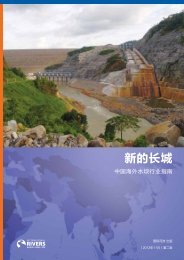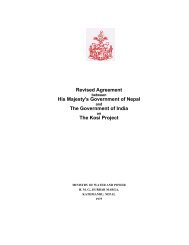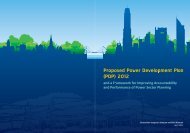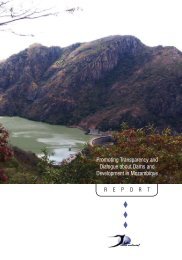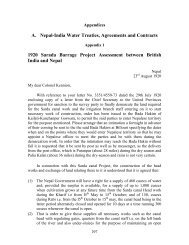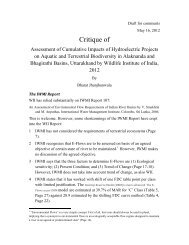Mountains of Concrete - International Rivers
Mountains of Concrete - International Rivers
Mountains of Concrete - International Rivers
Create successful ePaper yourself
Turn your PDF publications into a flip-book with our unique Google optimized e-Paper software.
A very robust finding <strong>of</strong> hydrological impact studiesis that warming leads to changes in the seasonality <strong>of</strong>river flows where much winter precipitation currentlyfalls as snow…This has been found in projections forthe European Alps…[and] the Himalayas… 128Apart from the glacial and snow melt, climate changewill also affect precipitation. The most recent (June 2008)IPPC “Technical Paper on Climate Change and Water”states that:Increases in precipitation at high latitudes in boththe winter and summer seasons are highly consistentacross models. Precipitation increases over the tropicaloceans and in some <strong>of</strong> the monsoon regimes, e.g., theSouth Asian monsoon in summer (June to August)and the Australian monsoon in summer (Decemberto February), are notable and, while not as consistentlocally, considerable agreement is found at the broaderscale in the tropics. 129Thus, to the extent that the Himalayan system is fedby the South Asian monsoon, this could mean increasedprecipitation, though caution is called for before reachingany conclusions. As “The Melting Himalayas” notes, “[I]ntensification <strong>of</strong> the Asian monsoon is predicted by mostclimate models. On a regional scale this could result inincrease in precipitation, although local effects are poorlyunderstood.” 130 It appears from the predictions about riverflows that the impact <strong>of</strong> glacial melting is likely to dominatethe effects <strong>of</strong> any increases in precipitation resulting in eventualdecline in flows <strong>of</strong> glacier and snowmelt fed rivers.Heavy precipitation events are also predicted toincrease. The IPPC’s “Technical Paper on Climate Changeand Water” says that “It is very likely that heavy precipitationevents will become more frequent. Intensity <strong>of</strong> precipitationevents is projected to increase, particularly in tropical andhigh-latitude areas that experience increases in meanprecipitation…In most tropical and mid- and high-latitudeareas, extreme precipitation increases more than meanprecipitation.” 131Other reports also support this prediction <strong>of</strong> an increasein extreme events. For example, a report by ICIMOD onthe impact <strong>of</strong> climate change on Himalayan glaciers says:On the Indian subcontinent, temperatures arepredicted to rise between 3.5 and 5.5ºC by 2100.An even higher increase is predicted for the TibetanPlateau (Lal 2002). Climate change is not just aboutaverages, it is also about extremes. The changein climate is likely to affect both minimum andmaximum-recorded temperatures as well as triggeringmore extreme rainfall events and storms. 132Extreme precipitation events are likely to lead to anincrease in the intensity and frequency <strong>of</strong> flash floods.To summarize, the picture that emerges in the Himalayasis that <strong>of</strong>:n An increase in the intensity <strong>of</strong> precipitation, leading tohigher flows and floodsn An increase in glacial and snow melt leading to an initialincrease in river flows and floodsn Subsequent disappearance or significant depletion <strong>of</strong>glaciers and snow leading to depleted flowsn Change in the seasonal distribution <strong>of</strong> total flowsImplications <strong>of</strong> Climate Change for DamSafetyThe likely implications for the region in general andhydropower projects in particular are serious. 133Most dams are designed based on historical data <strong>of</strong>river flows, with the assumption that the pattern <strong>of</strong> flowswill remain the same as in the past. Climate change haseffectively destroyed this assumption. It is likely that damswill be subjected to much higher flows, raising concerns<strong>of</strong> dam safety, increased flooding and submergence, ormuch lower flows, affecting the performance <strong>of</strong> such hugeinvestments. A changing seasonal balance in water flowscould even eliminate the rationale for storage dams.The increased rate <strong>of</strong> glacial and snow melt is likely tolead to higher river flows in the short-term. Also, one <strong>of</strong> themore robust predictions for climate change is an increasein the frequency <strong>of</strong> extreme events; extreme precipitationevents and other phenomenon can lead to large floods. Thesafety <strong>of</strong> dams in view <strong>of</strong> these increased flows/floods is amajor cause <strong>of</strong> concern. Even if a dam is able to survivehigher flows, bigger floods are likely to lead to higherbackwaters, increasing the areas affected by submergence.Another major cause for concern are glacial lakeoutburst floods (GLOFs). As glaciers melt, they can formlarge lakes behind temporary dams <strong>of</strong> ice and moraine. Whenthese dams fail, the water is released resulting in massive flashfloods. The Dig Tsho GLOF in Nepal is a good example.[See Box 7, page 34] The chapter on Freshwater Resources andTheir Management <strong>of</strong> the “IPPC Fourth Assessment Report”states that “Rapid melting <strong>of</strong> glaciers can lead to flooding<strong>of</strong> rivers and to the formation <strong>of</strong> glacial melt-water lakes,which may pose a serious threat <strong>of</strong> outburst floods…” 134This threat <strong>of</strong> a GLOF is intensified by global warmingas glacial melt increases. A paper by Shaun D. Richardson andJohn M. Reynolds states that “As glaciers recede in responseto climatic warming, the number and volume <strong>of</strong> potentiallyhazardous moraine-dammed lakes in the Himalayas isincreasing. These lakes develop behind unstable ice-coredmoraines, and have the potential to burst catastrophically,producing devastating Glacial Lake Outburst Floods(GLOFs).” 135The IPCC’s “Technical Paper on Climate Change andWater” points out that there has been an increase in theM o u n ta i n s o f C o n c r e t e : D a m B u i l d i n g i n t h e H i m a l aya s | 3 3








